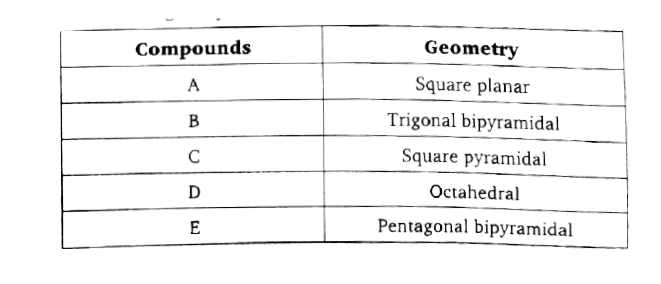If x and y are total number of electrons which are present in non-axial and axial set off d-orbitals respectively in Ni cation of [Ni(DMG)2], then calculate the value of 2x2y
The correct Answer is:36
To solve the problem, we need to determine the values of x and y for the nickel cation in the complex (Ni(DMG)2) and then calculate the expression 2x2y.
Step 1: Determine the oxidation state of Nickel in (Ni(DMG)2)
1. Identify the ligands: DMG (Dimethylglyoxime) is a neutral ligand.
2. Calculate the oxidation state: Since DMG is neutral, the oxidation state of Nickel (Ni) in the complex is +2.
Step 2: Determine the electron configuration of Ni²⁺
1. Nickel (Ni) atomic number: 28
2. Electron configuration of Ni: (Ar)3d84s2
3. For Ni²⁺: Remove 2 electrons from the 4s orbital.
- Thus, the electron configuration of Ni²⁺ is (Ar)3d8.
Step 3: Identify the geometry of the complex
1. Geometry of (Ni(DMG)2): The complex is square planar due to the strong field ligands (DMG).
2. Splitting of d-orbitals in square planar geometry: The d-orbitals split into two sets:
- Non-axial: dxy,dxz,dyz
- Axial: dx2−y2,dz2
Step 4: Count the electrons in the d-orbitals
1. Filling of d-orbitals for Ni²⁺ in square planar geometry:
- The 8 electrons in 3d8 will fill the orbitals as follows:
- dxy (1), dxz (1), dyz (1), dx2−y2 (2), and dz2 (0).
- Thus, the filling will be:
- dxy=2
- dxz=2
- dyz=2
- dx2−y2=2
- dz2=0
2. Count the electrons:
- Non-axial orbitals (dxy,dxz,dyz): x=6 (2+2+2)
- Axial orbitals (dx2−y2,dz2): y=2 (2 in dx2−y2 and 0 in dz2)
Step 5: Calculate the expression 2x2y
1. Substituting the values:
- x=6
- y=2
2. Calculate 2x2:
2x2=2×(62)=2×36=72
3. Calculate 2x2y:
2x2y=722=36
Final Answer:
The value of 2x2y is 36.
---
2. Calculate the oxidation state: Since DMG is neutral, the oxidation state of Nickel (Ni) in the complex is +2.
2. Electron configuration of Ni: (Ar)3d84s2
3. For Ni²⁺: Remove 2 electrons from the 4s orbital.
- Thus, the electron configuration of Ni²⁺ is (Ar)3d8.
2. Splitting of d-orbitals in square planar geometry: The d-orbitals split into two sets:
- Non-axial: dxy,dxz,dyz
- Axial: dx2−y2,dz2
- The 8 electrons in 3d8 will fill the orbitals as follows:
- dxy (1), dxz (1), dyz (1), dx2−y2 (2), and dz2 (0).
- Thus, the filling will be:
- dxy=2
- dxz=2
- dyz=2
- dx2−y2=2
- dz2=0
- Non-axial orbitals (dxy,dxz,dyz): x=6 (2+2+2)
- Axial orbitals (dx2−y2,dz2): y=2 (2 in dx2−y2 and 0 in dz2)
- x=6
- y=2
2. Calculate 2x2:
2x2=2×(62)=2×36=72
2x2y=722=36
The value of 2x2y is 36.
Topper's Solved these Questions
- CO-ORDINATION COMPOUNDSBook:VK JAISWALChapter:CO-ORDINATION COMPOUNDSExercise:LEVEL 1
Explore 202 Videos
- CO-ORDINATION COMPOUNDSBook:VK JAISWALChapter:CO-ORDINATION COMPOUNDSExercise:LEVEL 3 (PASSAGE TYPE)
Explore 97 Videos
- CO-ORDINATION COMPOUNDSBook:VK JAISWALChapter:CO-ORDINATION COMPOUNDSExercise:MATCH THE COLUMN
Explore 36 Videos
- CHEMICAL BONDING (BASIC)Book:VK JAISWALChapter:CHEMICAL BONDING (BASIC)Exercise:Level 3 (Passive 11)
Explore 6 Videos
- d-BLOCK ELEMENTSBook:VK JAISWALChapter:d-BLOCK ELEMENTSExercise:SUBJECTIVE PROBLEMS
Explore 6 Videos
Similar Questions
Knowledge Check
How many upaired electrons are present in Ni2+?
A0B2C4D4How many unpaired electrons are present in Ni2+?
A0B2C4D8The total number of electrons present in all s orbitals, all the p orbitals, and all the d orbitals of cesium ion are, respectively,
A8,26,10B10,24,20C8,22,24D12,20,22
How many non-axial d-orbitals are involved in hybridisation of CrO2Cl2?
View SolutionHow many electrons are present in dz2 orbital of [Ni(gly)2] ? .
View SolutionConsider the following compounds with their regular geometries.

Calculate value of (x+y−z)2, where x is total number of axial d-orbitals having zero nodal plane, y and z are total no. of non-axial and axial d-orbitals respectively each one having two nodal planes used in hybridisation of central atoms of compounds A to E.
View SolutionConsider the following compounds with their regular geometries.

Calculate value of (x+y−z)2, where x is total number of axial d-orbitals having zero nodal plane, y and z are total no. of non-axial and axial d-orbitals respectively each one having two nodal planes used in hybridisation of central atoms of compounds A to E.
View SolutionThe number of unpaired electron in Ni2+ is
View Solution
